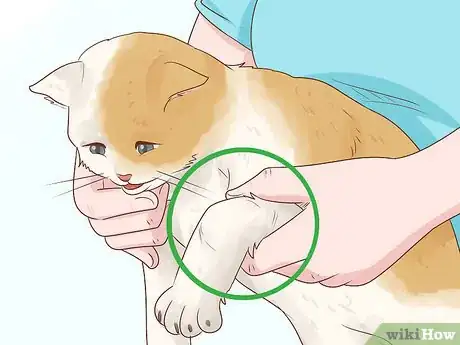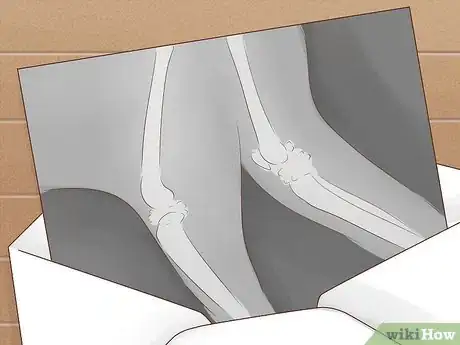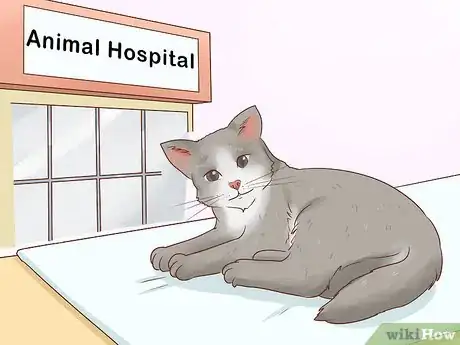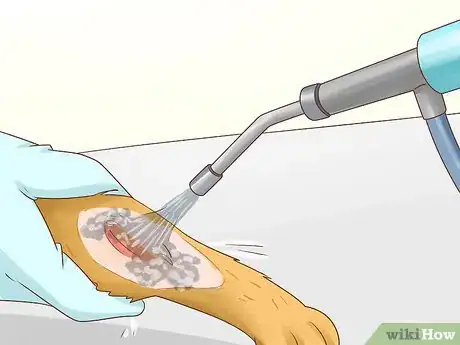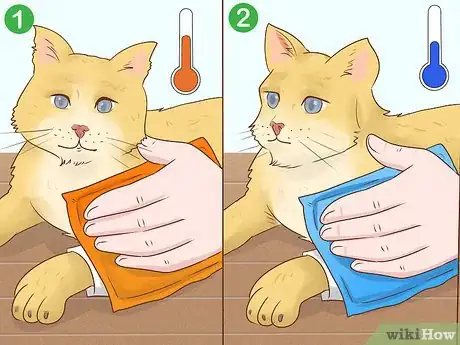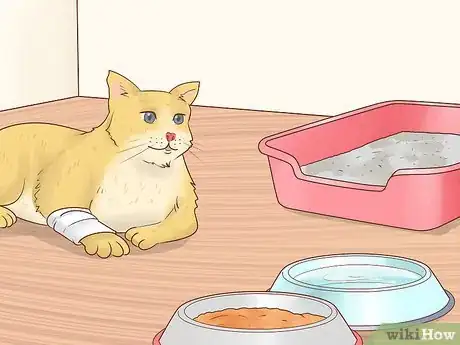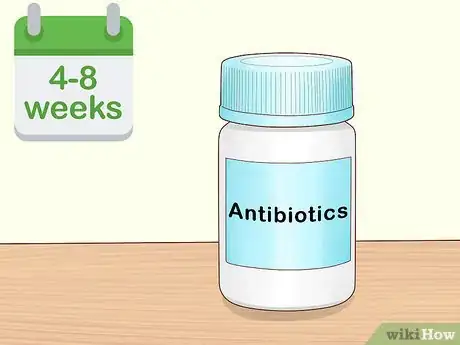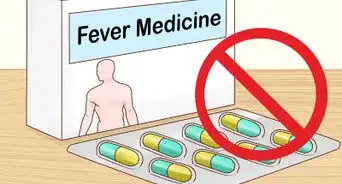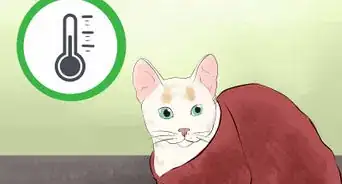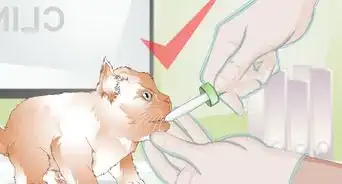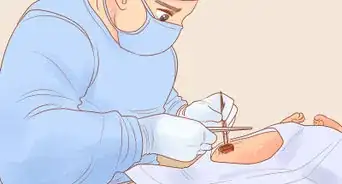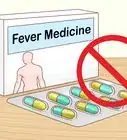This article was co-authored by Pippa Elliott, MRCVS. Dr. Elliott, BVMS, MRCVS is a veterinarian with over 30 years of experience in veterinary surgery and companion animal practice. She graduated from the University of Glasgow in 1987 with a degree in veterinary medicine and surgery. She has worked at the same animal clinic in her hometown for over 20 years.
This article has been viewed 15,341 times.
Older cats will sometimes slow down with age, and that's okay. But sometimes this slowing down is caused by arthritis – an inflammation in their joints. Septic arthritis is caused by bacteria living in those joints and can’t be treated in the same way as regular arthritis. Recognizing the symptoms of septic arthritis and getting your cat the proper care can help relieve its symptoms and make it more comfortable.
Steps
Recognizing Septic Arthritis Symptoms
-
1Look for a decreased range of motion. Because septic arthritis causes swelling in joints, it can prevent your cat from being able to move properly. If you notice your cat seems to be limping when it walks, it might have septic arthritis. Limping is a sign that your cat can't extend its legs as far as usual.[1]
-
2Check your cat’s joints. The joints affected by septic arthritis will show symptoms. They might be hot or swollen. When you touch one of your cat’s joints, it might yelp or hiss, since septic arthritis can also cause pain there.[2]
- If you are testing your cat's joints, do so gently. You don't want to cause your cat more pain that necessary.
Advertisement -
3Look for lameness in the affected limb. If the septic arthritis has advanced far enough, your cat might not be able to move the affected limbs at all. They’ll favor the other limbs that aren’t affected, dragging the ones that are.[3]
-
4Pay attention to your cat’s appetite. If your cat is in enough pain, it may lose its appetite. If your cat isn’t eating as much as it normally does, it can be a sign of septic arthritis. However, lack of appetite is a serious symptom regardless of what causes it, so if you notice it in your cat, you should take it to the vet right away.[4]
-
5Pay attention to your cat’s activity levels. If the septic arthritis has advanced far enough, your cat may not want to move at all. If you notice that your cat is lethargic and not willing to move much, it might have septic arthritis. Lethargy is also a symptom of other serious issues, so if you notice it, you should take your cat to the vet right away.[5]
Treating Septic Arthritis
-
1Order x-rays. The length of time your cat has been suffering from septic arthritis can affect how much additional damage there is. An x-ray will show you and your vet if there’s any permanent change in the joint structure caused by the inflammation.[6]
-
2Admit your cat to an animal hospital. For treatment, your cat will have to be admitted to your vet’s office or an animal hospital. Treatment often requires surgery – although it’s sometimes minimally invasive – and your cat will need to be sedated.[7] Your cat's vet will also likely want to examine your cat to assess his general health and check for any other conditions that may be compromising your cat's immune system. A weak immune system can predispose your cat to an infection, such as septic arthritis.
-
3Extract joint fluid from the infected joint. To determine the extent of the bacterial infection, your vet will extract joint fluid to perform a bacterial culture. This will tell your vet the best way to treat your cat’s septic arthritis.[8]
- You cat will be sedated for this, and your vet will be able to tell you how long the drugs will affect your cat.[9]
-
4Flush the joint. To get all of the bacteria out of the joint that’s affected, your vet might lavage – or wash – the joint. This will require your vet to put your cat under anesthesia, open its skin near the joint, and use a scope to clean out the joint.[10]
Caring for Your Cat After Surgery
-
1Alternate cold and heat packs at home. Once your cat is home from surgery, alternating hot and cold packs on your cats joints can give it some relief. Place a heat pack on the affected joints for 10 minutes. Swap it out for a cold pack and leave that on for the same amount of time. You can do this up to a couple of times a day.[11]
- Your cat might not be willing to sit still while you do this. Try holding your cat in your arms while you hold the packs to its affected limbs. Petting it and speaking to it in a soothing voice while you do so can help calm down your cat.
-
2Restrict your cat’s activity. While your cat heals, it’s important it doesn’t move more than it needs to. Place its food, water, and litter box near where it's resting. You should also prevent your cat from running and playing as much as possible.[12]
-
3Administer antibiotics for 4 to 8 weeks. The type of antibiotic you give your cat depends on the results of the bacterial culture your vet takes. Any other conditions, illnesses, and medications will also affect the type of antibiotic your vet prescribes. You should give them to your cat for four to eight weeks, even after their symptoms disappear.[13]
References
- ↑ https://vcahospitals.com/know-your-pet/septic-arthritis-in-cats
- ↑ https://vcahospitals.com/know-your-pet/septic-arthritis-in-cats
- ↑ http://www.petmd.com/cat/conditions/musculoskeletal/c_ct_arthritis_septic
- ↑ https://vcahospitals.com/know-your-pet/septic-arthritis-in-cats
- ↑ https://vcahospitals.com/know-your-pet/septic-arthritis-in-cats
- ↑ http://www.petmd.com/cat/conditions/musculoskeletal/c_ct_arthritis_septic
- ↑ https://vcahospitals.com/know-your-pet/septic-arthritis-in-cats
- ↑ https://vcahospitals.com/know-your-pet/septic-arthritis-in-cats
- ↑ http://www.petmd.com/cat/conditions/musculoskeletal/c_ct_arthritis_septic
About This Article
If your cat's joints are swollen or if it drags one of its feet when it walks, it may be suffering from septic arthritis, which is a condition caused by bacteria in your cat's joints. To treat your cat's septic arthritis, take it to the veterinarian, who will most likely perform surgery to determine what type of bacteria is causing the infection. From here, they will prescribe antibiotics that you will need to administer to your cat for as long as recommended, even after symptoms disappear. To make sure your cat heals fully and properly, you should also try to keep it from moving around more than it needs to by placing its litter box, food, water, and bed all in the same area. For more advice from our Veterinary co-author, like how to use cold and heat packs to soothe your cat's septic arthritis, read on!

